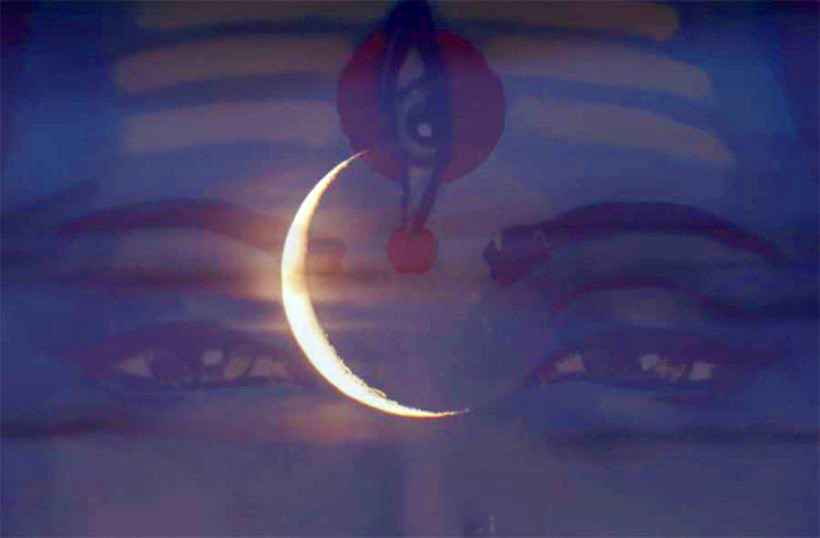
by Somya Devi | Mar 11, 2021 | Astrology, Conjunctions, Holy Days
New Moon and Maha Shivaratri, March 2021
The Sun and Moon join near the end of sidereal Aquarius on the dark night of March 12th, with an exact alignment under the New Moon at 5:21 am ET on Saturday, March 13th. Mercury and Venus also join the Moon and Sun in Aquarius, while Saturn (with Jupiter in sidereal Capricorn) once again rules over 6 grahas at the time of the New Moon. Mars and Rahu continue their conjunction in sidereal Taurus, opposite Ketu in Sagittarius, forming a Kala Sarpa Yoga in the sky. Thursday night, the fourteenth night of the waning Moon, marks the Maha Shivaratri celebration this month. Sun and Moon begin this cycle in the Vedic nakshatra Purva Bhadrapada, an auspicious sign for spiritual advancement.
Aquarius Cycle
With the new lunar cycle beginning in Aquarius, the coming month may have a quirky and forward-thinking tone, and we may see some scientific advances this month. The Mars Rover landing actually occurred just days after the Sun had entered its Aquarius cycle. Aquarius is in fact very much about service to the greater good. With Saturn strong in his own sign, we could see many significant advances in social support structures right now.
Aquarius is known as Kumbha in Sanskrit, a word for “pitcher” or “vessel.” According to the Vedic texts, the sign Kumbha can be imagined as a man holding a pot, with deep-brown skin, standing in the water. We can see this Aquarian imagery in the sadhus of India (and its biggest ritual pilgrimage day, the Kumbha Mela), who make their lives an offering of service to society through their prayers and Saturnian austerities, while renouncing the individual self. In the Aquarius cycle, we think about how we can serve the whole.
Maha Shivaratri
Thursday night, March 11th in North America, the night prior to the Dark Moon night, is the fourteenth waning phase of the lunar cycle. During this month this night is celebrated as Maha Shivaratri. This is the most auspicious night of the year for doing sadhana (spiritual practice). It is traditional on this night to stay up all night fasting, chanting, praying, and meditating. This holiday honors Lord Shiva, the great ascetic, as we recall two stories of great sacrifices that he made protect the entire creation.
One of these is the story of the gods and demons churning of the milk ocean in order to release the nectar of immortality. Before the nectar came up, however, a poison came up first. (This is similar to when we do spiritual practice and begin our path of self-inquiry, and negative tendencies often come to light first, which can be a painful experience. Similarly, during a physical fast or cleanse, toxins can be shaken loose and released first, causing a healing crisis before we continue healing into a freer, happier state of being.) When the poison came up from the milk ocean, Lord Shiva consumed it so that it would not engulf humanity, as a great and noble sacrifice. His wife, Parvati, however, held his throat so that he could not ingest it, thus saving him from being harmed by the poison.
Maha Shivaratri also commemorates the wedding of Shiva and Parvati, which also stemmed from great sacrifice made for the benefit of all humanity. It was said that after his first wife, Sati, perished, Shiva was fully devoted only to his sadhana, meditating for aeons in isolation and renouncing the world. Then the demon Tarakasura began running amock on earth, threatening all of humanity. Brahma foretold that only Shiva’s child could defeat Tarakasura, so the gods devised a plan for Sati to reincarnate as Parvati, and win over her Lord to marriage once again to produce this heir. Shiva was not easily swayed, however, and it was only after Parvati became an ascetic and underwent great penance that he agreed to marry. They eventually produced their son Kartikkeya, who went on to slay the demon.
Thus, this holiday is celebrated through the penance of fasting, forgoing food, water, and sleep, for one night, and simultaneously celebrating the union of Lord Shiva and Parvati, or the masculine and feminine energies of creation, that allows the dance of life to continue. It is an apt time to feel the forces of Aquarius upon us, which compel us to consider our role in society, and in the universe, and what personal sacrifices we can make for the greater good. Even if you’re not able to stay up the whole night, any amount of devotional practice, serviceful sacrifice, or chanting of Om Namah Shivaya on this night can have beneficial affects that are magnified greater than on any other night.
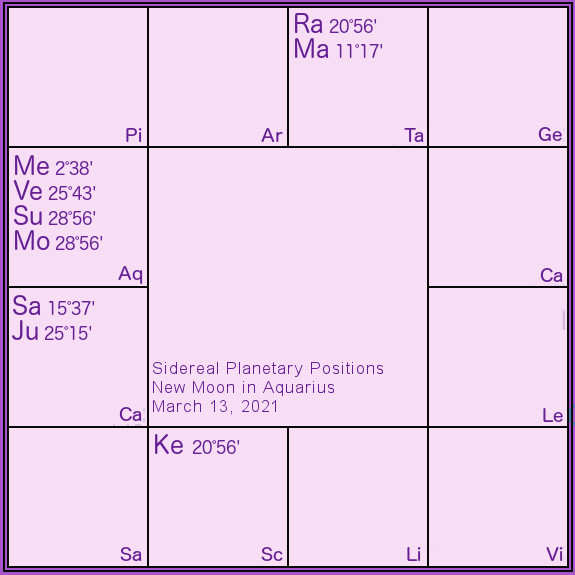
Kala Sarpa Yoga
This year’s Kala Sarpa yoga cycles continue, as Rahu and Ketu appear to cut the sky in half with all planets to one side of the nodal axis. Kala Sarpa can be translated as “black snake” or the “serpent of time,” and intensifies subtle forces on all levels, including inner challenges as well as strengths and yogic combinations in a chart. Mars joins Rahu in Taurus, and tho he will transit out of Taurus and into Gemini in one month, technically breaking the cycle, the intensity brought on by the alignment can sometimes continue when only one planet has crossed to the other side of the sky.
Purva Bhadrapada
The former “lucky-footed one” is the Vedic nakshatra (star-sign) where Sun and Moon begin this lunar cycle. This nakshatra bridges Aquarius and Pisces and is often represented by a funeral cot, symbolizing the transition from life into death, or ultimate liberation. It is ruled by Aja Epakada, the one-footed goat who is often associated with the image of Lord Shiva as Nataraj dancing on one foot, a fitting image for Maha Shivaratri.
Om Namah Shivaya!
Personal Chart Readings with Coaching Are Available Here
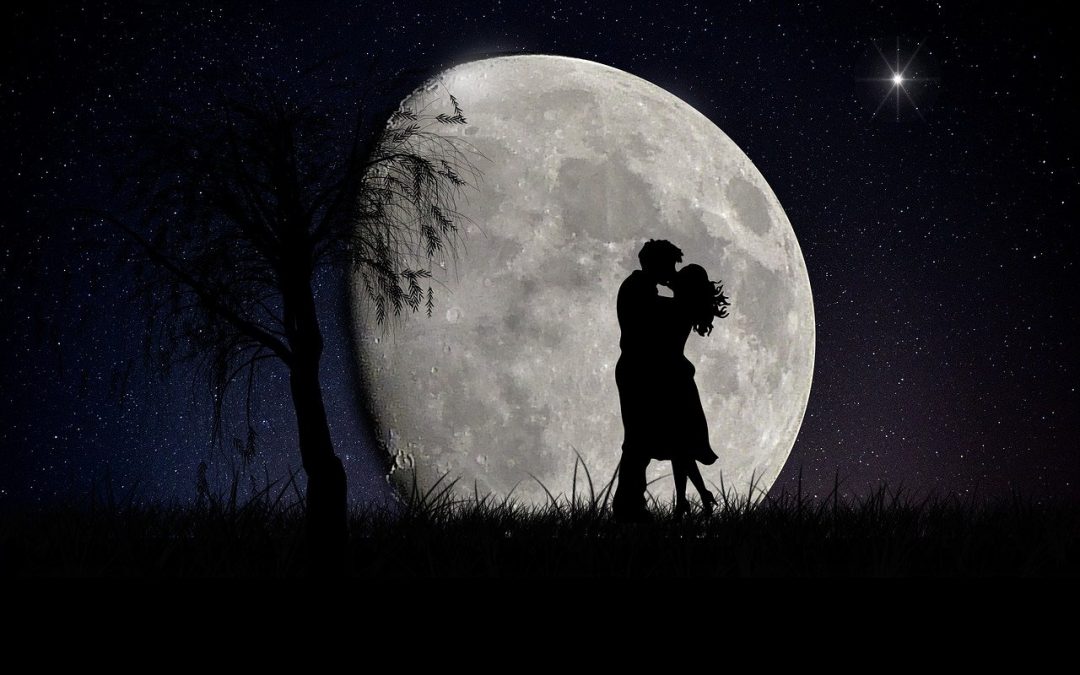
by Somya Devi | Feb 25, 2021 | Astrology
Full Moon February 2021
The Moon waxes towards fullness this Friday night for a Full Moon in sidereal Leo Saturday morning at 3:17 am ET. Opposite the Sun and Venus in sidereal Aquarius, the Moon is illuminated in Purva Phalguni nakshatra, “the former reddish one,” near Regulus, one of the brightest stars in the night sky. With Mercury now direct, all planets are moving forward for the time being.
Leo Full Moon
As the Sun transits sidereal Aquarius, we find our power center connected to ideas of service, community, and the greater good. The Vedic symbol for Aquarius is someone pouring a pitcher of water. We often think of this as the ascetic pouring holy water to bless the earth. But we cannot pour and share with the world unless we have found a way to fill our own cup. Aquarius’ opposite, Leo, is a place where we embrace our individual power, and purify our own heart so that it can radiate outward to everyone around us.
If you’ve been spending a lot of time in service, community, or contemplation of your contributions to the world, this full Moon can help you reflect a bit more on your personal kingdom. Is it in order? Is your cup full? Are you feeling radiant? The Leo full Moon is a time to celebrate your inner radiance, as the Sun reflects through all of us as the life-giving source.
Purva Phalguni
The middle of Leo comprises Purva Phalguni nakshatra, ruled by Bhagha, the god of delight. It is controlled by Venus and is a star that relates with luxury, decadence, and sexual passion. Symbolized by the front legs of a bed, or a hammock, this star elicits relaxation and other bed pleasures. If you have been burning inside in order to fulfill your duties or please others, take a break! This full Moon is a time to have fun, relax, and enjoy life a bit.

Saturn, Jupiter and Mercury
Lightening up during this time is perhaps easier said than done while Saturn still commands rule over much of the celestial energy. He remains strong in his own sign of Capricorn, bringing us down to earth and reminding us of our responsibilities and need for structure. Jupiter and Mercury join him there, coloring our analytical as well as philosophical sides with a rather austere palette. He rules over the Sun, and Venus, both in Aquarius.
Saturn, Jupiter and Mercury all remain in Shravana nakshatra, a star of listening. Despite the outward nature of the full Moon it is still a good time to listen to the inner voices that are trying to teach us something.
Mars and Rahu
Mars joins Rahu now in sidereal Taurus, a combination that can create volatile passions and flare-ups of all kinds. Mars aspects the full Moon (and thus Rahu’s energy gets caught up as well), which could light a fire in our hearts or minds this weekend. This could add to the romantic passions but also let some hot-headedness get the best of us if we aren’t careful.
Personal Chart Readings with Coaching Are Available Here
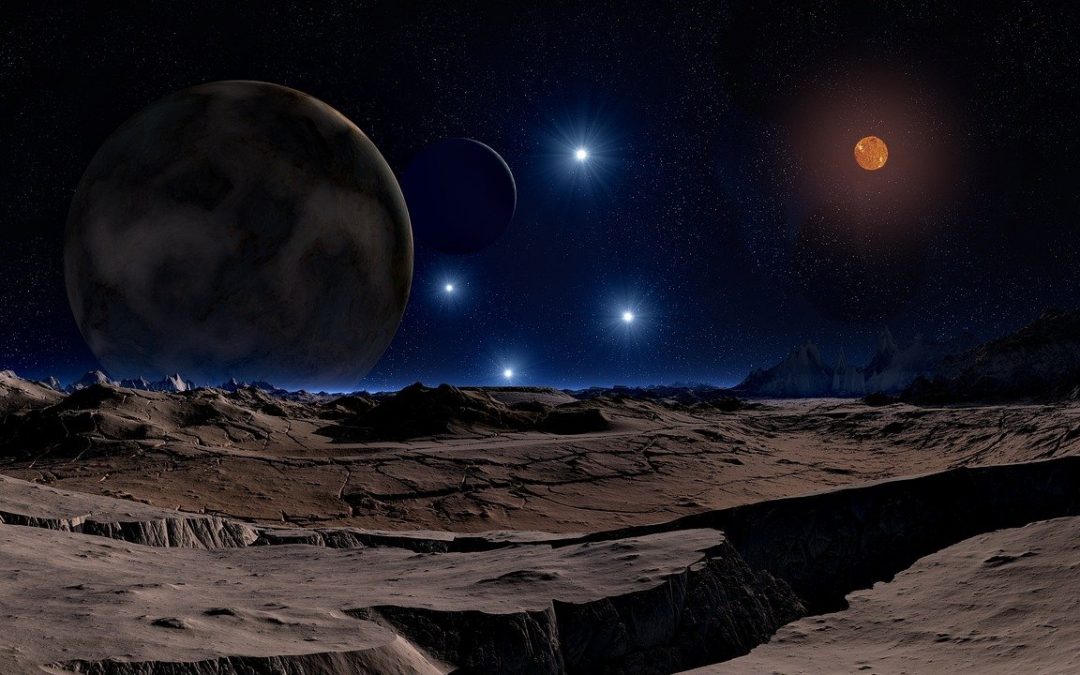
by Somya Devi | Feb 11, 2021 | Uncategorized
New Moon February 2021
Today the Sun and Moon join at the very end of sidereal Capricorn for a New Moon at 2:06 pm EST. By tomorrow both Sun and Moon will move into sidereal Aquarius, where the Sun will transit for most of this cycle. Both signs are ruled by Saturn, who is joining Sun and Moon in Capricorn as we begin this cycle. Jupiter, Venus, and retrograde Mercury are also there, bringing us a heavy dose of Capricorn energy in a very weighted chart, with all these planets between the two nodes who create a Kaala Sarpa yoga.
New Moon in Capricorn
Saturn has been in his own sign of Capricorn since January of 2020. This earth-sign is about being responsible, focusing on structure, family, and commitments. With Saturn here for the last year he has been strong in his own sign, putting the pressure on us to work hard for what is most important, and spend less time on the frivolous. Saturn pressures us to be mature but his heavy influence can feel like a restrictive weight. As we begin another cycle under strong Saturn’s influence, we may feel like life is a bit serious and difficult right now.
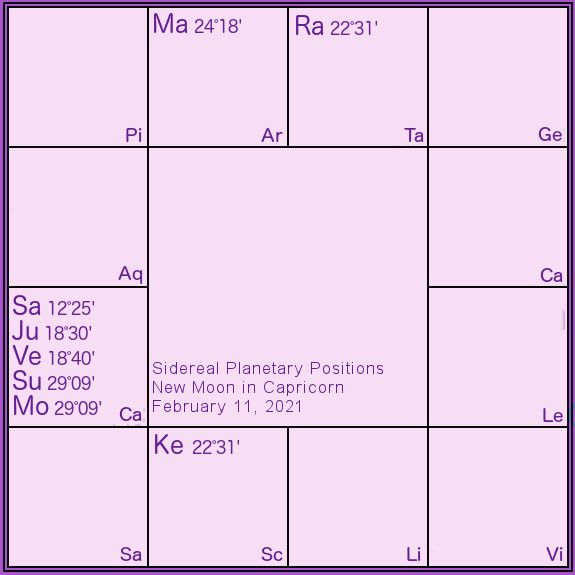
Planetary Pileup: Dhanishtha and Sravana Nakshatras
At the moment of this new Moon we have 6 of the 9 grahas in sidereal Capricorn, with Sun and Moon in Dhanishtha nakshatra and Saturn, Jupiter, Venus, and retrograde Mercury all in Sravana nakshatra.
Dhanishtha is the star of wealth (dhana), and thus it does give us the opportunity to start this month with a mindset of prosperity. It is symbolized by the musical drum, showing that we must keep a steady beat, finding the rhythm that is right for us, in order to succeed. Symbolized by the female lion, we can be brave and fierce while also meeting the basic responsibilities of providing for our families. The deities who rule Dhanishtha are the eight Vasus, the elemental deities. This can be a good time to connect with these principles through the study of Ayurveda, especially examining how the elements are at play within each of us.
With four planets in Sravana nakshatra, the universe is asking us to “Listen!” The star of hearing, and symbolized by an ear, Sravana is where we can listen deeply to the lessons that are being taught by the cosmos. As with any New Moon, this is an opportune time of month to be more inward, tuning into the voice of the heart instead of the chatter of the mind and the external world. Lord Vishnu, the preserver of the universe, presides here, further encouraging us to maintain that which is around us as we seek inner wisdom.
With so many planets in both of these nakshatras this lunar cycle could be a good time to begin projects that require long-term commitment and hard work. Take note, however, of the planetary war going on between Jupiter and Venus…
Planetary Wars
Jupiter and Venus war when they come within 1 degree of each other in the sky, which they will be until 9:31 am EST on February 12th. Neither planet is incredibly strong and luminous already because of their proximity to the Sun — they rise and set during the daylight hours so are not currently visible. Jupiter is debilitated in Capricorn (though neecha bhangha, somewhat helped due to ruler Saturn’s presence there). Therefore beginning any ventures ruled by these two would be less than ideal during the planetary war, and best to wait until after that time has passed. That would include ventures in the arts, music, love, children, education, learning or teaching.
Venus and Mercury will engage in planetary war from February 12th through 13th, and then Mercury will war with Jupiter from the 13th through 15th. After Mercury stations and ends his retrograde journey on the 20th, he will pass by Jupiter again for another war from March 2nd through the 6th.
Kaala Sarpa
With all planets clustered together right now (except for lone Mars, who transits his own sign of Aries), the nodes Rahu and Ketu cut the chart sharply in half with no planets on the other side of their axis. This creates the somewhat dreaded Kaala Sarpa yoga — the “black snake” or “serpent of time.” This adds a weight to the chart that compels all of us to dive deeper into sadhana in order to work with the energies at hand. A lot of what is going on may be subconscious or karmic, and requires looking at the aspects of our lives that are difficult to see or understand. The kaala sarpa energy will pervade until Mars enters Gemini on April 14th.
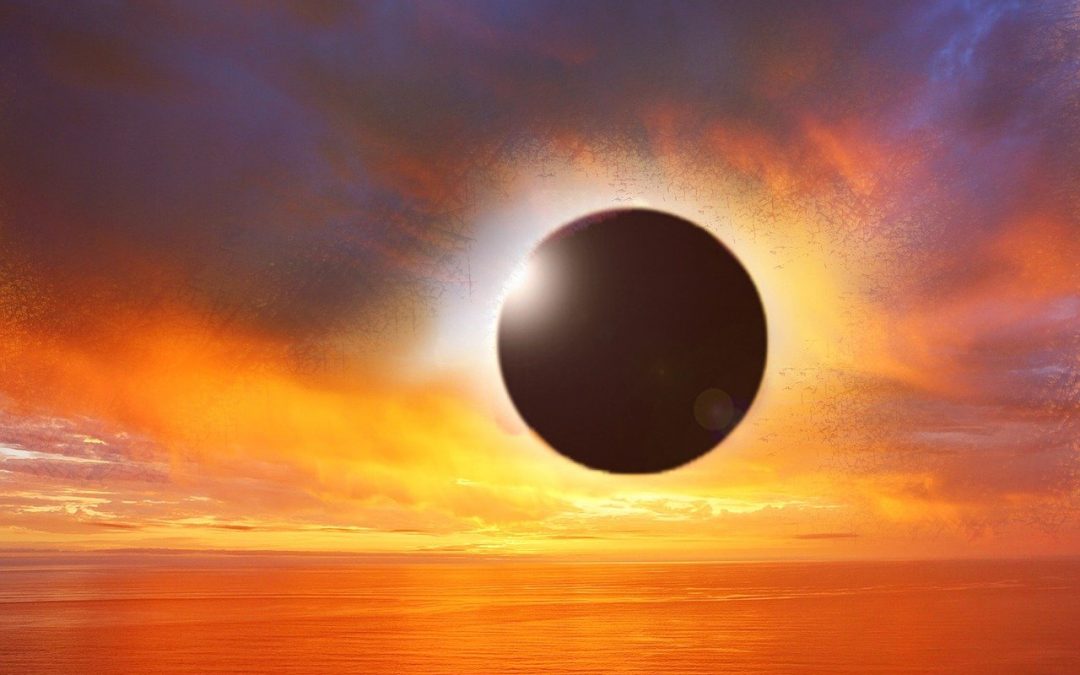
by Somya Devi | Dec 13, 2020 | Astrology, Conjunctions, Eclipses
New Moon and Solar Eclipse in Scorpio
The Sun and Moon come together on this Dark Moon night, joining near the end of sidereal Scorpio as they come towards a full conjunction at 11:17 am ET on December 14th for a New Moon in Scorpio. Their conjunction is also aligned closely enough with the south node, Ketu, that it will cause a total Solar Eclipse from 8:33 am through 1:53 pm ET, with the maximum eclipse at 11:13 am ET. The eclipse will only be visible from South America and small portions of Africa and Antarctica.
Total Solar Eclipse
In a total solar eclipse the Moon passes between the earth and the Sun, causing a shadow to appear over the Sun. This only occurs when Earth, Sun, and Moon are also closely aligned with the nodes, Rahu and Ketu, who are thought of as the shadow planets for this reason. These planets represent our deepest subconscious drivers. They are like our blind spots because we are not able to see them. During “eclipse season,” however, the shadows begin to become visible. This is a very important time of year to pay attention to any shadow work / inner demons / red flags that are arising for you. Great transformation is possible if we pay attention and do the work to honor what is being revealed.

This is the first set of eclipses to occur with the nodes in their new positions. Rahu and Ketu entered Taurus and Scorpio, respectively, in September, and will transit here for a year-and-a-half, creating three eclipse cycles on this axis along their way. Whatever house-axis sidereal Scorpio-Taurus is in your natal chart, and whatever planets you have there, will be affected greatly by this eclipse cycles and the ones coming over the next year. This is where you have the most work to do and may be facing the most challenges currently.
On a global level, we experience this eclipse elevating the apparent tension between our desire for material stability (Taurus) and overhauling change, surprises, and even loss (Scorpio). We may find ourselves more dependent upon or obsessed with one of these areas, while not allowing enough room for the other in our lives. In a personal chart analysis we can apply these ideas to whatever is affected in the natal chart.
New Moon in Scorpio, Sun cycle in Sagittarius
The total Solar Eclipse naturally coincides with the alignment of Sun and Moon, thus begins a new lunar cycle with Sun and Moon in Scorpio. As they are currently at the very end of sidereal Scorpio, the Sun will spend most of this cycle in Sagittarius, so we will experience a Sagittarian cycle with some Scorpion flavor. In the Sagittarius cycle we feel the radiant power of the Sun, and our inner power, fulfilled by acts of service and charity aligned with our highest beliefs. Sagittarius is a fire sign (a sign for action) ruled by Jupiter (principles, beliefs, and higher teachings). The Scorpio flavor will remind us that all actions and principles are also vulnerable to change, and this could allow us to find some growth around our inner-most core beliefs.
Jupiter-Saturn War & Total Conjunction
On December 21st, the winter solstice, Jupiter and Saturn will have an exact conjunction at 6 degrees 21 minutes of sidereal Capricorn, owned by Saturn himself. Though they align in the same sign every 20 years, this is the closest visible conjunction of the two in nearly 800 years. The last alignment was in May of 2000, a powerful transition point that ushered us into a new century, a new age of technology with the boom of the internet, and soon after a major change in the tone of society and world politics with the events of September 2001, including a major economic downturn.
The position of Saturn here in his home sign has put a lot of pressure on society already, and is largely related to the global pandemic and the continued constraint that we feel across the world and in our individual homes as well. With Jupiter entering Saturn’s sign, he attempts to bring some understanding, some learning, and some principles for us to work with as we navigate the stern imposition of Saturn in our lives. Can we learn anything from this? Can we check in with our beliefs and make sure that we are acting in accordance with them? Can we act in favor of these and in ways that are responsible towards our long-term goals, rather than frivolous?
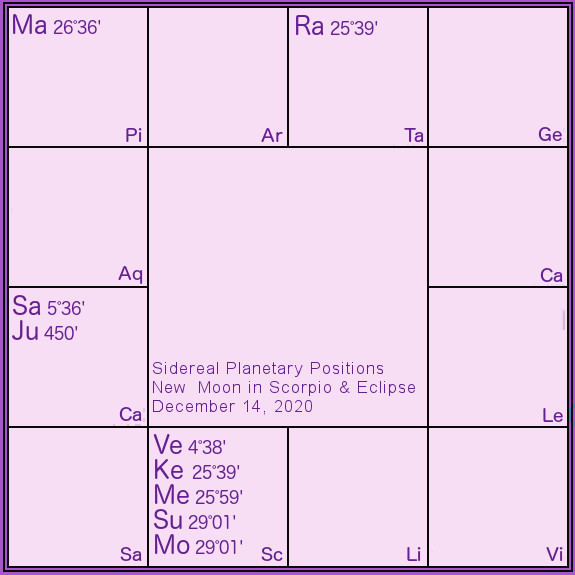
The challenge is that, in Vedic thought, when two planets come very closely together, within one degree, it is considered a graha yuddha or planetary war. Who wins? Well, Jupiter is in fact much brighter in the sky, giving him a strong advantage at claiming our attention. But Saturn has proved incredibly strong right now being in his home sign of Capricorn. When two planets are at war, both will suffer to some degree, and their power in our lives may temporarily wane.
We may find that our principles, beliefs, and ideas don’t even feel like they are inspiring us or filling us with the faith we are seeking at the moment. And our efforts to stay strong, determined, and persevering through the shut down—and the other challenges in our lives— may feel depleted. Hold tight! The planetary war between these two runs from December 12th through December 30th.
Since this war is occurring in the 10th sign, hence the 10th house for a world chart, it relates strongly to government. The outright war for power between political figures in the U.S. may not subside until after December 30th, though we can admit it is hurting both sides and the governmental authority itself.
In our own lives, we may find things ruled by Jupiter and Saturn, the associated people, and the houses aligned with Scorpio, Taurus, and Capricorn may all be facing challenges during this month. Within all this there are learning opportunities offered by the planets, if we work to get to know them better and the highest purposes that they have to offer us.
Personal Chart Readings with Coaching Are Available Here
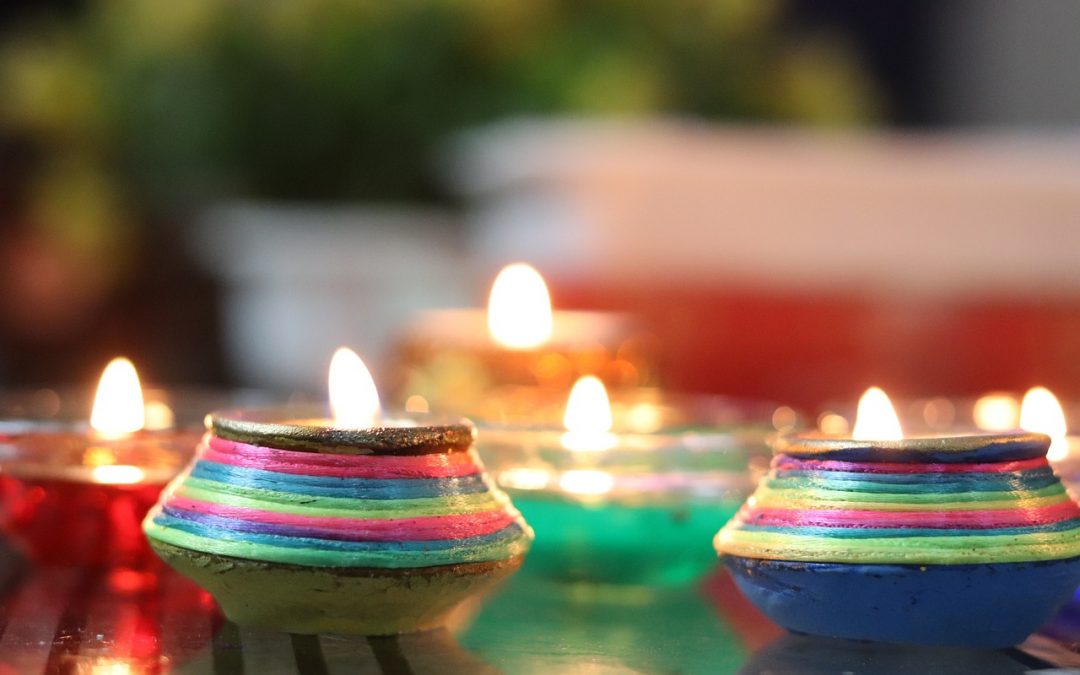
by Somya Devi | Nov 14, 2020 | Astrology, Conjunctions, Eclipses, Holy Days, Planets Changing Signs, Uncategorized
New Moon in Libra and Diwali 2020
The Sun and Moon will join at 29° sidereal Libra tonight, with exact alignment for a New Moon at 12:07 am EST. This Dark Moon night commemorates the Hindu holiday of Diwali, the festival of lights. Tonight will actually be the third but main night of the Diwali celebrations, which began on Dhanteras on November 12th. Be sure to light some candles tonight to celebrate light itself, as we move into the darkest part of the year in the north.
Scorpio cycle
The Sun and Moon again join at the very end of one sign, sidereal Libra, before both moving into Scorpio later the same day. Hence we are beginning the cycle of the Sun in Scorpio, but flavored with a certain Libran energy. The Scorpio Sun cycle is a time that compels us to look deeply into our own deep well of emotion, as Scorpio is both a water and insect sign, driving us towards the flow of emotions that is trapped within our external protective shell. Ruled by Mars, the warrior planet, we can see Scorpio as a spiritual warrior, and this time of year is an important one for exploring our personal vulnerabilities and sensitive places that may need more strength, courage, and healing.
Flavored by the Libra position of Sun and Moon as we begin this cycle, this investigation may lean heavily towards studying how we behave in relationships, what drives us to find balance and compromise, what wounds we are protecting that are keeping us from enjoying the happiness and balance that Venus wants to offer us.
Remembering that while Sun is debilitated in Libra, our sense of strength or our literal health may be weak this month. We continue to contemplate what it takes to maintain our personal strength and not become depleted while also relating with others and seeking outer balance. This is a very important time of year to nourish ourselves, and our inner light, as the outer light is descending. You can also make some herbal tea to nourish yourself during this vata (cold and dry) season. The nature of the Scorpio cycle will show us where we carry inner imbalance that requires some more harmonizing and lightening.
Vishaka Nakshatra
The Sun and Moon join in Vishaka nakshatra, a sign that bridges the end of Libra and the beginning of Scorpio. The “two-branched” sign is ruled by two deities, Lord Indra, the chief of the Gods, and Lord Agni, fire personified. This sign can harness a lot of power and leadership ability, but only once we choose the proper direction. You may find yourself at a crossroads this month and need to call in your guides to help you to choose the right direction, after which a lot of success is possible. The animal symbol for Vishaka is the male tiger.
Diwali
On the new Moon of the Hindu month of Ashwin (this month), we celebrate Diwali, the festival of lights. The festival began this year on November 12th (North America), on the 13th waning Moon phase of the previous cycle. This day is known as Dhanteras, or Dhanvantari Tryodashi, the celebration of the birth of Lord Dhanvantari, the father of Ayurvedic medicine. If you practice any healing tradition, especially Ayurveda, it is a good day to give thanks and call in auspicious blessings to your healing path or practice. Diwali is strongly associated with the Goddess Laxmi, and is a powerful time to connect with her, calling in her blessings for both material and spiritual prosperity.
We celebrate Diwali while the days are getting noticeably shorter and darker, and it is a time to invite more light into our lives, our hearts, and our world. This festival celebrates the victory of light over darkness, which is something to rejoice in and have faith in, even if we can’t outwardly observe it sometimes. Creating positive vibrations internally is the best way to begin growing and spreading them externally.
Diwali also commemorates Lord Ram’s and Sita’s return from exile after fourteen years (a story from the Ramayana). Lord Ram embodies the highest qualities of dharma, devotion, compassion, courage, and leadership. Diwali is also the start of a new lunar cycle, so it’s a great time to go within and summon these qualities to awaken and live through you.
Diwali (also seen as Divali, Deepawali or Deepavali) comes from the Sanskrit words deepa (light) and avali (row). It is traditional to light candles throughout Diwali (opt for electronic tea lights if you’re in a fire danger zone!), inviting the highest light into our homes and lives. The candles are lit to remind us of the inner divine light in us all. Though one flame can be used to light many others, it is not diminished by sharing its power of illumination. We can pray for the peace and happiness of all beings, and each one’s awareness of their inner light.
Eclipses
We are now entering the “eclipse season,” as we approach two eclipses that will occur November 30th and December 14th. With the nodes having recently moved onto their new axis—Rahu in Taurus and Ketu in Scorpio—this could activate some latent energy that has been lurking, unresolved in the shadows, in the areas of life that align with these two signs in your Vedic natal chart.
Be sure to watch for any disruptions, and any red flags, over the next month, and be sure not to make hasty decisions out of stress. Sadhana is very important, especially during the eclipses themselves, and doing inner work to investigate what is arising can serve in helping us to make important changes. This is the first eclipse cycle of three that will occur over the next year-and-a-half while the nodes transit this axis, so it is a jumping off point in seeing what work we need to do in these areas of our lives.
To see how the current transits affect and interplay with your chart and karma, you can request a personal reading here.










